Children on the autism spectrum often have trouble tolerating sedentary activities, particularly sitting still. Sitting or lack thereof may not sound like a big deal in theory, but sitting tolerance is a critical aspect of the learning process.
It can have significant consequences on the child’s performance at school, social interactions, and family relationships.
Sitting tolerance skills can help children
- pay attention
- follow instructions
- retain information
- and at times, recreate whatever they have learned
With that said, children with autism may find it more difficult to develop sitting tolerance due to sensory processing issues and deficits in social and communication skills. To help your teen, we thought we’d offer a few tips on how to improve sitting tolerance in autism.
How to Improve Sitting Tolerance in Autism
It is not uncommon to hear about children with autism spectrum disorder (ASD) who struggle to sit still. This may be due to sensory-motor issues, which refer to problems in how they interpret sensory information and translate it into motor movements. Similarly, it may also be caused by hyperactivity or a short attention span, which often causes them to fidget repeatedly.
Fortunately, there are ways to help your child become more tolerant of sitting. Here are some key components to include in developing a structured intervention plan to encourage them to develop the habit of sitting in place.
To get started, you’ll need to:
- provide a distraction-free environment
- designate a separate time and play for learning
- and create a separate time and place for playing
Your child may scream, cry, or react violently from changing how he/she normally plays and studies. However, do not let this deter you from your progress. Avoid making eye contact with your child and do not comment on his or her behavior as this may trigger a meltdown. Simply ignore what you don’t want to encourage, and positively reinforce the desired behavior.
3 Activities and Exercises to Improve Sitting Tolerance
To help you improve sitting tolerance in toddlers, here are some activities that you can include in your intervention plan.
1. Sensory Diet
As mentioned earlier, sensory issues are a common reason children with autism have difficulty sitting still. Thus, one way to help them is by working with an occupational therapist to build them a sensory diet, a group of activities designed to help your child manage their sensory processing to learn more effectively.
Some common activities used in a sensory diet include
- animal walks
- playing with tactile items like slime, clay, or kinetic sand
- chewy foods, and the like.
These all engage your child’s different senses — touch, sight, hearing, smell, and taste to help them become more tolerant to sitting.
2. Therapy Ball
If the idea of sitting on a chair does not go well with your child, you can consider having him or her sit on an exercise or therapy ball first. A therapy ball allows for some movement, so this may help address potential issues with hyperactivity.
3. Fidget Toy
Fidget toys may also help your child sit for a longer time by keeping him or her preoccupied. For some, these will hold their attention and keep them engaged and busy so that they subconsciously stay seated while playing.
Whatever activities you decide to include in your plan, remember that consistency is key.
Children with autism develop habits best through repetitive behavior, so you should do the same activities at the same time and place each time.
Sitting Tolerance Takeaway
Sitting still for extended periods can be difficult for anyone, but particularly challenging for children on the autism spectrum due to sensory issues. And this can deeply impact their learning and social life. But you can help your child(ren) by providing fun activities that encourage remaining in place as well as providing stimulating sensory activities.
Interested in getting your child engaged in a fun, interactive therapy to practice sitting tolerance using telehealth and virtual reality game-like apps?
To speak with a team member, call us at 857-990-6111 Ext. 1 or register for an appointment.












